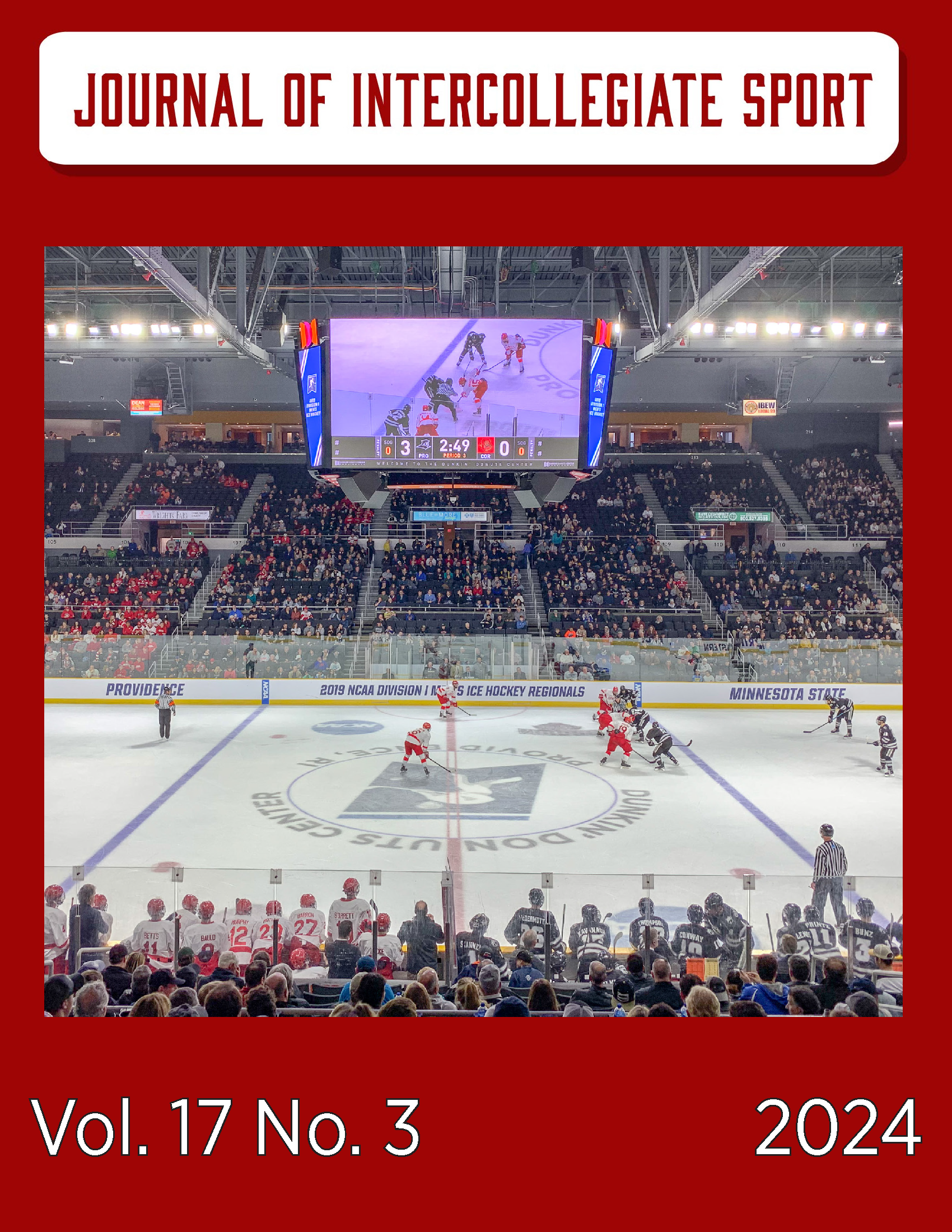College Sport Communicator Leaders’ Perceptions of Sport Information Operations
DOI:
https://doi.org/10.17161/0kncfv44Keywords:
College Athletic Communicators, Sport Information Directors, Intercollegiate Athletics, Person-Environment FitAbstract
Recent research indicates College Athletic Communicators (CACs) could benefit from more staff in the communication department (Elliott et al., 2023). However the request may not be supported by administration as additional staffing may not fit in the budget. Therefore, it appears imperative to evaluate no-cost options to alleviate the feelings of being under-appreciated and overworked. The College Sport Communicators (CSC) professional association may be a strong advocate for the profession and may have the ability to provide needed resources for those serving in CAC positions. Therefore, the research presented in this study aims to explore the perspective and experiences of CSC leaders to evaluate how to better serve the CAC profession with an understanding of limited resources. In this study, semi-structed interviews with CSC leaders were conducted. Data provided by the participants indicate ways for CACs to avoid burn out and how athletic administrators can work to support the profession.
Downloads
References
Barnhill, C. R., Smith, N. L., Oja, B. D., Barnhill, C. R., Smith, N. L., & Oja, B. D. (2021). Personality and Fit. Organizational Behavior in Sport Management: An Applied Approach to Understanding People and Groups, 93-102.
Blaszka M., Cianfrone B. A., Walsh P. (2018). An analysis of collegiate athletic departments social media practices, strategies, and challenges. Journal of Contemporary Athletics, 12(4), 271–290.
Brewer, R. (2000, June). Where are we headed? CoCSCA Digest, 50(6), 10
Bunch, N., Cianfrone, B. A., & Beasley, L. (2023). A Critical Analysis of Coaches’ Perceptions of Athletic Department Involvement in Team-Related Social Media Activism. International Journal of Sport Communication, 1(aop), 1-14
Cable, D. M., & Judge, T. A. (1996). Person–organization fit, job choice decisions, and organizational entry. Organizational behavior and human decision processes, 67(3), 294-311. https://doi.org/10.1006/obhd.1996.0081
Chatman, J. (1989). Improving interactional organizational research: A model of person-organization fit. Academy of Management Review, 14(3),333–349. https://doi.org/10.5465/amr.1989.4279063
Chelladurai, P. (2014). Managing organizations for sport and physical activity: A systems perspective. Taylor & Francis.
College Sport Communicators. (n.d.). College Sports Information Directors of America. Our Organization: What is College Sports Communicators? https://collegesportscommunicators.com/sports/2013/7/25/general.aspx
College Sport Communicators. (2023, August 18). Our organization: What is college sport communicators? College Sport Communicators. https://collegesportscommunicators.com/sports/2013/7/25/general.aspx
Corbin, J., & Strauss, A. (2008). Basics of qualitative research (3rd) ed.). Sage.
Elliott, K., Williams, T.A., & Bunch, N. (2023). The most forgotten, but often most forgotten department: Sports information – The intersection between human capital and managerial operations in Division II athletics. Sports Innovation Journal, 4, 71-84.
https://doi.org/10.18060/26504
Eisenhardt, K. M. (1989). Building theories from case study research. Academy Of Management Review, 14(4), 532-550.
Hardin, R., & McClung, S. (2002). Collegiate sports information: A profile of the profession. Public Relations Quarterly, 47(2), 35.
Huml, M., & Taylor, E. (2021). Why employees are fleeing the college athletics industry. Sportico: The business of sports. https://www.sportico.com/leagues/college-sports/2022/why-employees-are-leaving-college-athletics-1234687903/
Kristof‐Brown, A. L., Zimmerman, R. D., & Johnson, E. C. (2005). Consequences of Individual Fit at work: A meta‐analysis OF person–job, person–organization, person–group, and person–supervisor fit. Personnel psychology, 58(2), 281-342. https://doi.org/10.1111/j.1744-6570.2005.00672.x
Kristof‐Brown, A. L., & Billsberry, J. (2012). Fit for the future. Organizational Fit: Key Issues and New Directions, 1-18. https://doi.org/ 0.1002/9781118320853
Miles, M.B., & Huberman, A.M. (1994). Qualitative data analysis: An expanded sourcebook. Sage Publications.
Moore, J. (2012). Strategic influence in college sports public relations. CoCSCA E-Digest, 47–54.
Patton, M.Q. (2002). Qualitative research and evaluation methods (3rd ed.). Thousand Oaks, CA: Sage Publications.
Pedersen, P. M., Laucella, P., Geurin, A., & Kian, E. (2020). Strategic sport communication. Human Kinetics Publishers.
Sanderson, J. (2011). To tweet or not to tweet: Exploring Division I athletic departments’ social-media policies. International Journal of Sport Communication, 4(4), 492-513. https://doi.org/10.1123/ijsc.4.4.492
Sanderson, J., Snyder, E., Hull, D., & Gramlich, K. (2015). Social Media Policies within NCAA Member Institutions: Evolving Technology and its Impact on Policy. Journal of Issues in Intercollegiate Athletics, 8. http://csri-jiia.org/old/documents/publications/research_articles/2015/JIIA_2015_8_3_Policies.pdf
Sanderson, J. (2023). Critiquing the social media scholarship in sport studies: Looking beyond content and adopting critical approaches. International Journal of Sport Communication, 16(3), 262-265.
Spall, S. (1998). Peer debriefing in qualitative research: Emerging operational models. Qualitative inquiry, 4(2), 280-292.
Stoldt, G.C. (2000, January). Current and ideal roles of NCAA Division I-A sports information practitioners. Cyber-Journal of Sport Marketing, 4 (1).
Stoldt, G. C. (2013). College athletics communications: Evolution of the field. In P. M. Pedersen
(Ed.), Routledge handbook of sport communication (pp. 482-492). Routledge. https://doi.
org/10.4324/9781315088556-49
Stoldt, G. C., & Vermillion, M. (2013). The organizational roles of college athletics communicators: Relationship to the use and perceptions of social media. International Journal of Sport Communication, 6, 185–202. https://doi.org/10.1123/ijsc.6.2.185
Taylor, E. A., Lee, L., Huml, M. R., & Lopez, C. (2022). Impacts of career commitment, gender, and job position on turnover intentions among athletic department employees: a moderated mediation model. European Sport Management Quarterly, 1-21.
Tracy, S.J. (2012). Qualitative research methods: Collecting evidence, crafting analysis, communicating impact. West Sussex, UK: John Wiley & Sons.
Wheeler, A. R., Coleman Gallagher, V., Brouer, R. L., & Sablynski, C. J. (2007). When person‐organization (mis) fit and (dis) satisfaction lead to turnover: The moderating role of perceived job mobility. Journal of Managerial Psychology, 22(2), 203-219. https://doi.org/10.1108/02683940710726447
Whiteside, E. A. (2014). New media and the changing role of sports information. In A. C. Billings, & M. Hardin (Eds.), Routledge handbook of sport and new media (pp. 143–152). Routledge.
Yao, K., Zhang, J., Qin, C., Wang, P., Zhu, H., & Xiong, H. (2022, May). Knowledge Enhanced Person-Job Fit for Talent Recruitment. In 2022 IEEE 38th International Conference on Data Engineering (ICDE) (pp. 3467-3480). IEEE.
Downloads
Published
Issue
Section
License
Copyright (c) 2024 Kelly Elliott

This work is licensed under a Creative Commons Attribution-NonCommercial-NoDerivatives 4.0 International License.
Copyright is held by the authors.


